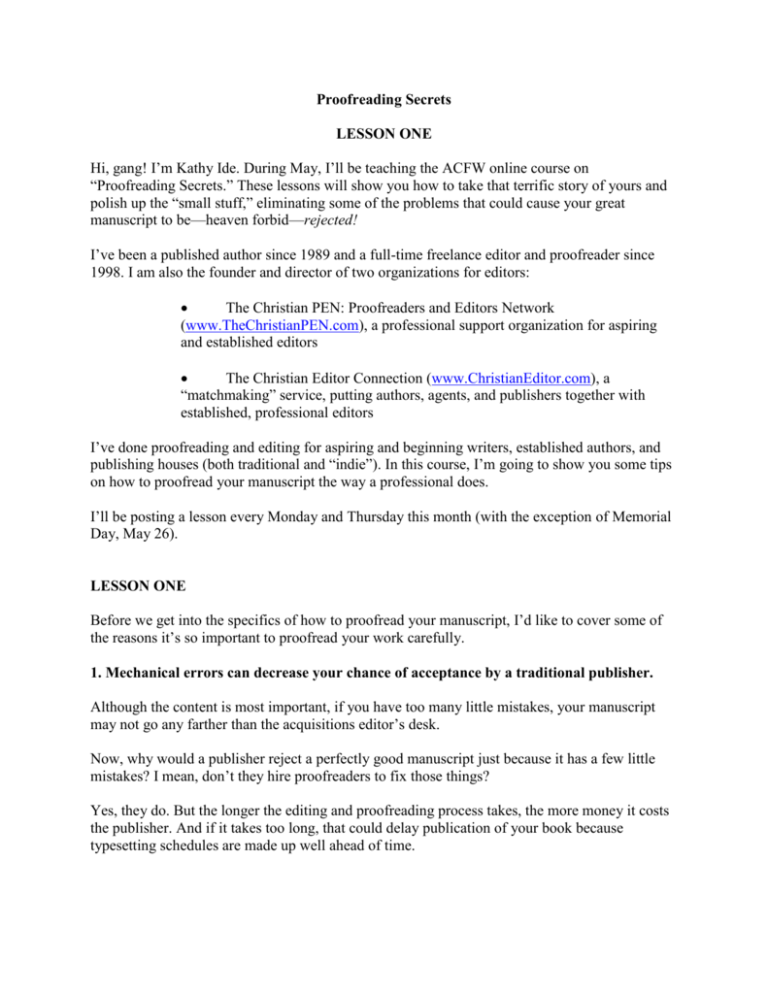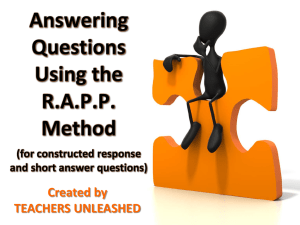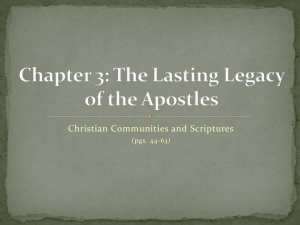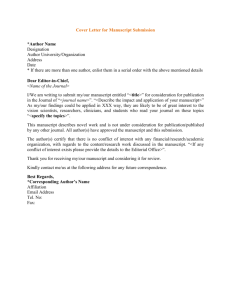Lesson 1 - Proofreading Secrets
advertisement

Proofreading Secrets LESSON ONE Hi, gang! I’m Kathy Ide. During May, I’ll be teaching the ACFW online course on “Proofreading Secrets.” These lessons will show you how to take that terrific story of yours and polish up the “small stuff,” eliminating some of the problems that could cause your great manuscript to be—heaven forbid—rejected! I’ve been a published author since 1989 and a full-time freelance editor and proofreader since 1998. I am also the founder and director of two organizations for editors: The Christian PEN: Proofreaders and Editors Network (www.TheChristianPEN.com), a professional support organization for aspiring and established editors The Christian Editor Connection (www.ChristianEditor.com), a “matchmaking” service, putting authors, agents, and publishers together with established, professional editors I’ve done proofreading and editing for aspiring and beginning writers, established authors, and publishing houses (both traditional and “indie”). In this course, I’m going to show you some tips on how to proofread your manuscript the way a professional does. I’ll be posting a lesson every Monday and Thursday this month (with the exception of Memorial Day, May 26). LESSON ONE Before we get into the specifics of how to proofread your manuscript, I’d like to cover some of the reasons it’s so important to proofread your work carefully. 1. Mechanical errors can decrease your chance of acceptance by a traditional publisher. Although the content is most important, if you have too many little mistakes, your manuscript may not go any farther than the acquisitions editor’s desk. Now, why would a publisher reject a perfectly good manuscript just because it has a few little mistakes? I mean, don’t they hire proofreaders to fix those things? Yes, they do. But the longer the editing and proofreading process takes, the more money it costs the publisher. And if it takes too long, that could delay publication of your book because typesetting schedules are made up well ahead of time. In addition, if a manuscript has mechanical errors, the publisher is going to wonder what else is wrong in that manuscript. If the author couldn’t be bothered to look up how a word is supposed to be spelled, or how a sentence should be punctuated, how does the publisher know whether that author did her research in other areas? Besides, you don’t want an acquisitions editor looking at your manuscript and thinking, You know, this author has some good things to say, but she doesn’t know a comma from a semicolon. 2. Mechanical errors can cause miscommunication. Take a look at this sentence: The inheritance will be divided equally between Tom, Dick and Harry. OK, so, Tom, Dick, and Harry each get a third of the inheritance, right? WRONG! There are two things in that sentence that indicate otherwise. 1. Between is used when dividing into two; among is used for more than two. For each of those people to get one-third, the sentence would have to read “divided equally among ...” So, if you need to divide an inheritance into two equal parts, but you’ve got three people who each get a piece of the pie, how do you determine how much those people get? 2. Without a comma between Dick and Harry, Tom gets half; Dick and Harry split the other half. Now, if you’re Tom, that might sound pretty good. But if you’re Dick or Harry, you probably won’t be too happy about the whole deal. If you’re the author of the will, your money and possessions may not be distributed in the way you intended. 3. Mechanical errors can cause confusion. I once e-mailed my older son, Tom, to ask him what he wanted me to make for dinner that Sunday. Here’s his response, just as he wrote it: When you decide what you can say I decided this and if it’s not OK that’s OK. It took me a while to decipher that. And when I asked my son for permission to quote him, his response was, “Did I write that? What on earth does it mean?” Even he didn’t know! Well, after reading that line a few times, I came up with this: When you decide what, you can say, “I decided this,” and if it’s not OK, that’s OK. Pretty confusing without the punctuation, is it? 4. Mechanical errors may cause readers to take you, and your message, less seriously. I once saw an article with this title: Crowe Turns Hero to Help Snake Bite Boy The story was about actor Russell Crowe helping a boy who’d been bitten by a snake. But by spelling snakebite as two words, this sentence implies that Mr. Crow helped a snake bite a boy! Now, I got a good laugh out of that. But I sure don’t want those kinds of mistakes showing up in my writing. 5. Mechanical errors can give Christians and Christianity a poor reputation with the world. Several years ago, James Dobson expressed concern over a video called “We Are Family.” Keith Olbermann, a nationally known commentator, derided Dr. Dobson for getting so upset about the video. He received a couple of thousand e-mails from concerned Christians who agreed with Dr. Dobson’s views. But he said that many of those e-mails contained gross typos and errors in punctuation, usage, grammar, and spelling. He included a few examples on his web page. Here are three of his excerpts. Please try a litter harder to get your facts straight. I find it quite a show of hypochondria on your part that you absolutely refuse to find out the truth about Dr. Dobson’s comments. There needs to be a stop on people who distortes Christians who speaks out on the truth of God’s word. Christians have the right to say what ever. Put a stop on this, or first thing you know they will be doing you the same way. Now, in that last e-mail especially, I’m guessing that English may not be this person’s native language. But Olbermann quoted these as examples of how stupid Christians are. And yes, he used the word stupidity. Granted, we all tend to make typos and other mistakes in our e-mails. E-mails are usually informal messages sent to friends and family who don’t care if we misspell words or misuse grammar. And it’s so easy to click “Send” without bothering to proofread and fix any typos there might be. But as Christians, it’s important to realize that the world is watching us carefully. They’re just waiting for us to make mistakes, actually hoping we will make mistakes so they can “prove” that Christians are stupid and, therefore, Christianity is only for the uneducated and easily duped. As Christian authors, we are even more closely scrutinized and criticized than the general public. Many people in this country refuse to buy or read Christian books because they don’t think our books are as well written as those that are published by the secular press. They consider Christian writers and publishers “inferior.” And if they find errors in a Christian book, they will use those errors as “proof” of their point. Let’s not give them any fuel for the fire of that argument. Proofread your manuscripts carefully so that your work reflects positively on your faith and your Lord. Tools of the Trade Words and punctuation marks are the tools of a writer’s trade. It is vital for you to know how to use your tools properly. So, how can you find out how to use those important tools? Fortunately, you don’t have to ask a bunch of people for their opinions and then go with the answer that gets the most votes. There really are reference books you can turn to for the answers. These books are the “owner’s manuals” for the tools of your trade. If you are a professional author, it is absolutely imperative that you own these books. #1. A dictionary. That may seem obvious. But, believe it or not, there are some differences between different dictionaries. Merriam-Webster’s Collegiate Dictionary is the one used by traditional book publishers in the US. #2. If you write for newspapers or magazines, you need The Associated Press Stylebook. If you write books, or short stories that will be included in books, you need The Chicago Manual of Style. #3. Christian publishers also use The Christian Writer’s Manual of Style. Some of what’s in that book is covered in the Chicago manual, but this goes into more detail on aspects that are particularly relevant to Christian publishing. #4. Another reference that may come in handy for you is my book Proofreading Secrets of BestSelling Authors. It contains tips from some of the top multi-published authors in Christian publishing on how to proofread for typos, inconsistencies, and inaccuracies. It also highlights some of the punctuation, usage, grammar, and spelling issues that a lot of writers struggle with. On Thursday, I’ll post some of the tips I’ve learned about proofreading for typos and inconsistencies. In the meantime, I’d love to hear about any “owner’s manuals” for the tools of the trade that you’ve found to be particularly helpful in proofreading your manuscripts. Kathy Ide Author of Proofreading Secrets of Best-Selling Authors www.KathyIde.com www.ChristianEditor.com www.TheChristianPEN.com







